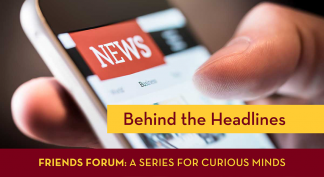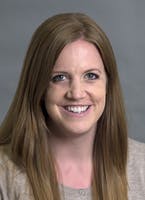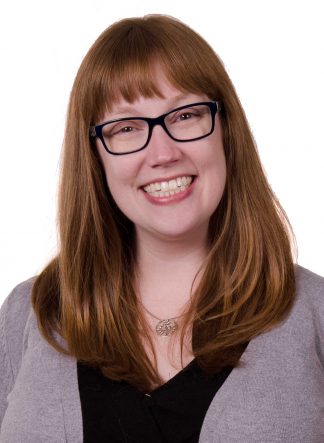By Allison Campbell-Jensen
 The landscape of news media has changed and to navigate it, news consumers need to be savvy, journalism students need to be curious, and reporters need to be ethical. These were aspects of the news discussed at the Oct. 21 event, “Behind the Headlines: Reporters and news consumers in a 24/7 media world,” sponsored by Friends of the Libraries.
The landscape of news media has changed and to navigate it, news consumers need to be savvy, journalism students need to be curious, and reporters need to be ethical. These were aspects of the news discussed at the Oct. 21 event, “Behind the Headlines: Reporters and news consumers in a 24/7 media world,” sponsored by Friends of the Libraries.
The concept of “data voids,” for example, occurs when there are high levels of demand for information but with low levels of information available on search engines or social media platforms, said Gayle Golden, a Senior Lecturer and Morse Alumni Distinguished University Teacher in the Hubbard School of Journalism. This can happen with breaking news: searches on YouTube or Google may produce deliberately false information designed to take advantage of that data void. So news consumers need to be wary.
From the reporter
Today in Minnesota and around the country, there are “news deserts,” places where community newspapers have closed and “there’s no one covering the school board,” said Kelly Smith, a Star Tribune reporter for 10 years.
COVID is the culprit, as it caused the bottom to fall out of advertising which, with subscriptions, is one of the two supports for the newspaper business. While the Star Tribune hasn’t had layoffs in a decade, the staff has shrunk from about 380 in 2006 to 240 now and the entire news staff took eight unpaid furlough days due to COVID-related advertising losses. Recently, City Pages, owned by the Star Tribune, folded, as did the Minneapolis community newspaper, the Southwest Journal.
Still, the news continues. Beat reporters are “mini experts,” said Smith, who covers nonprofits. Story creation starts with an idea, pitched to an editor, written, and then reviewed by a copyeditor who checks names and critical facts.
In all they do, Star Tribune reporters adhere to a code of ethics. They cannot participate in political activities — even put a bumper sticker on their cars. They don’t pay for information and, with a few exceptions, they identify their sources.
From the journalism professor
“What’s the difference between truth and a fact?” That was a recent topic of conversation between Golden and her husband, also a journalist. “A fact is true, and truth needs more than facts,” she replied. Truth includes an emotional element of trust, she said.
Among the principles of journalism she teaches her students is that their first obligation is to the truth — putting reliable facts in context. “Our first loyalty is to citizens,” she added. Journalists need to follow practices so they can verify what they find, and they must have independence from those they cover.
Students need to break through barriers to ask questions. “Young people have been taught to the test,” Golden said, so they feel questions are risky. She encourages their curiosity and critical thinking. Students need to diversify their news diets, even while they build their skills.
She also teaches them to analyze how a news story is constructed: What might be missing? Is there bias evident? What are the motives of sources? This media literacy is important for journalism students — and all students, in fact, because everyone needs to know how navigate today’s news environment.
From the librarian
Developing that critical eye is key to being an effective consumer of news and other information, said Lindsay Matts-Benson, who teaches information literacy to students. It’s difficult for students to discern what news is important, with so much information coming at them, some driven by algorithms, bias, commercialization, and click bait.
She asks students to examine sources carefully and find their best, most trusted sources for academic and popular information, local and national news. Students ought to question why a piece was written and check claims for accuracy. They can check into sources. And they can use Google to do a reverse image search.
These steps will help them be responsible when sharing information — to not be moved by their emotions but to understand the value of the news.
Is the news more editorial than ever before?
A person who had trained at the School of Journalism in the early 1990s was taught then that news was to be neutral — and asked the panel about the editorial feel of much of the news. Golden replied that because of social media, there’s an impression that is the case. She added that there is “more noise, more news sites and more partisanship generally.” Cable TV evening shows that market outrage are another contributor.
“The landscape has changed,” she said. But the question boils down to: What do you mean by “the news media?” she said. Most reputable media outlets like the Star Tribune continue to practice the same principles of journalism that have been taught for many years.







